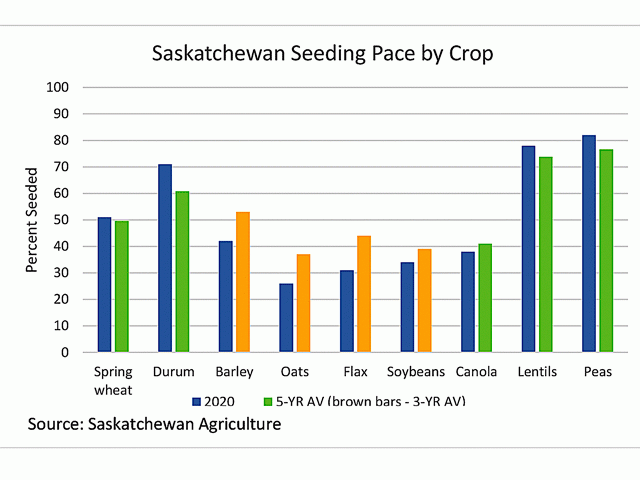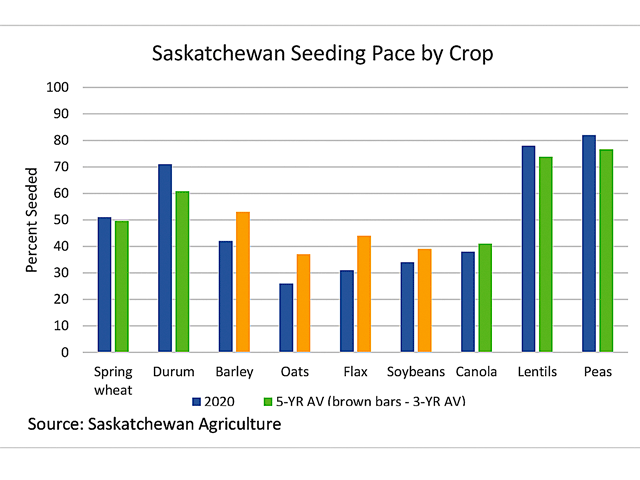Canada Markets
Saskatchewan Planting Pace Leaps Ahead
Planting in Saskatchewan took a large jump over the week ended May 18, with an estimated 51% of the province's crop seeded, up from 18% the previous week. This brings the pace of seeding equal to the five-year average of 51%, well ahead of the 10-year average of 38%.
The 33-point jump in acres covered from May 11 to May 18 is ahead of the 26-point jump in the five-year average reported from one week to the next, although is slightly behind the 35-point jump achieved over the same week in 2019 to 73% complete. The 73% of acres seeded as of this week in 2019 was 24% ahead of the previous five-year average.
While gains were realized across all six regions of the province, the range was wide, with an estimated 23% of the acres seeded in the Northeast Region all the way to 45% of the acres covered in the West-Central Region of the province, given the province's estimates.
P[L1] D[0x0] M[300x250] OOP[F] ADUNIT[] T[]
Only two regions out of the six are ahead of their respective five-year average. The Southwest Region is 74% complete, a pace that is 8 points ahead of average, while the West-Central Region is 59% complete, 11 points ahead of average.
When the five-year average pace is considered across all six regions, we see that the ground covered in the West-Central Region over the past week was 15 percentage points higher than average, 12 points higher in the Southeast and 10 points higher in the Southwest. The other three regions -- the East-Central, the Northwest and Northeast -- were all estimated at 2 points ahead of average.
As seen on the attached chart, crops that benefited from the faster pace in the southern regions and West-Central Region were spring wheat (51%), durum (71%), lentils (78%) and peas (82%), with this week's percentage of seeded acres in parenthesis. All four crops are ahead of their respective five-year average pace and could easily result in more acres seeded than estimated in Statistics Canada's preliminary estimates.
The canola planting and soybean planting are just behind their average pace for this week at 38% and 34% complete, respectively.
The crop is off to a good start. An estimated 75% of the province shows topsoil moisture rated as adequate, down from 84% the previous week, but still the highest rating for this week in four years. Over the previous week, the area rated short topsoil moisture grew from 11% to 20% of the province, while the area rated very short grew from 0% to 3% of the province. The combined area rated short- to very-short topsoil moisture of 23% is down from 56% this time last year and is the lowest rating for this week in three years.
A glance at the Cropland Topsoil Moisture Conditions map shows the driest area of the province concentrated along the Alberta border in west-central Saskatchewan. Drier areas are scattered around the Moose Jaw region as well as south of Wynyard. DTN's 7 Day Total Precipitation Forecast points to chances of rain for the western and north-western side of the province as well as the south-eastern side, while DTN forecasts indicate that the potential exists for frost and snow for regions of the Prairies next week, which bears watching.
Cliff Jamieson can be reached at cliff.jamieson@dtn.com
Follow him on Twitter @Cliff Jamieson
© (c) Copyright 2020 DTN, LLC. All rights reserved.






Comments
To comment, please Log In or Join our Community .